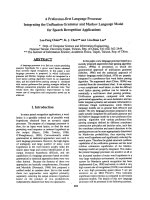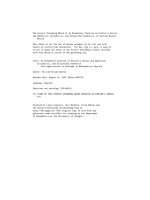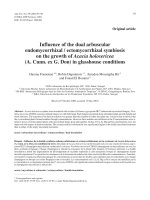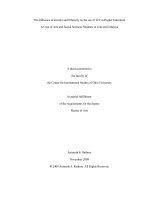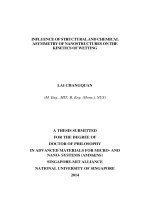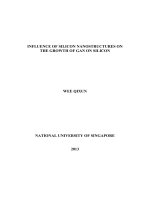The influence of surfactants on the solubilization, extraction and biodegradation of model polycyclic aromatic hydrocarbons
Bạn đang xem bản rút gọn của tài liệu. Xem và tải ngay bản đầy đủ của tài liệu tại đây (1.09 MB, 245 trang )
THE INFLUENCE OF SURFACTANTS ON THE
SOLUBILIZATION, EXTRACTION AND
BIODEGRADATION OF MODEL POLYCYCLIC
AROMATIC HYDROCARBONS
LI JINGLIANG
NATIONAL UNIVERSITY OF SINGAPORE
2004
EXTRACTION AND EFFECTS OF SURFACTANT ON
BIODEGRADATION OF MODEL POLYCYCLIC
AROMATIC HYDROCARBONS
LI JINGLIANG
(M. Eng. TIANJIN UNIV)
A THESIS SUBMITTED
FOR THE DEGREE OF DOCTOR OF PHILOSOPHY
DEPARTMENT OF CHEMICAL & BIOMOLECULAR
ENGINEERING
NATIONAL UNIVERSITY OF SINGAPORE
2004
i
ACKNOWLEDGEMENT
I would like to express my gratitude to my supervisors, Dr. Chen Bing-Hung for his
instructive and patient supervision throughout this project, and A/P Bai Renbi for his
great help at the late stage of my work.
I also would like to take this chance to thank my colleagues in the research group and
the laboratory officers at the department for their help in the experimental work.
Finally, thank the National University of Singapore for providing the financial support
to this research project and the scholarship during my study in NUS.
ii
TABLE OF CONTENTS
ACKNOWLEDGEMENT i
TABLE OF CONTENTS ii
SUMMARY vi
NOMENCLATURE viii
LIST OF FIGURES xii
LIST OF TABLES xvii
Chapter 1 Introduction 1
1.1 Research Background 1
1.2 Objectives 8
1.3 Organisations of This Thesis 9
Chapter 2 Literature Review 12
2.1 Solubilization of PAH by Nonionic Surfactants 12
2.1.1 Factors Affecting Solubilization 12
2.1.2 Quantitative Study on Solubilization 16
2.2 Aqueous Phase Behaviour of Nonionic Surfactants 18
2.2.1 Micelle Formation in Aqueous Solution 18
2.2.2 Factors Affecting CMC of Nonionic Surfactants 22
2.2.2.1 Surfactant Chemical Structure 22
2.2.2.2 Temperature 23
2.2.2.3 Electrolytes 23
2.2.2.4 Solvents 24
2.2.3 Clouding Phenomenon 24
2.2.3.1 Lower Consolute Behavior 24
2.2.3.2 Mechanisms of Clouding Phenomenon 25
2.2.4 Factors Affecting Cloud Point 27
2.2.4.1 Surfactant Molecular Structure 27
2.2.4.2 Effects of Additives 29
2.2.5 Applications of Clouding Phenomenon 34
2.3 Cloud Point Extraction and Its Limitations in Previous Studies 35
2.4 Effect of Surfactant on Biodegradation 44
iii
2.5 Biodegradation of Surfactant 50
2.6 Properties and Applications of Tergitol Surfactants 52
2.6.1 Applications of Tergitol 15-S-X Surfactants 52
2.6.2 Selection of Surfactants 54
Chapter 3 Materials and Methods 57
3.1 Reagents 57
3.1.1 Surfactants 57
3.1.2 PAHs 57
3.1.3 Salts and Alcohols 58
3.1.4 Medium for Bacterial Cultivation 58
3.2 Sand 59
3.3 Bacteria 59
3.4 Apparatus 60
3.4.1 HPLC 60
3.4.2 Light Scattering 61
3.4.3 Drop Shape Surface Tensiometer 62
3.4.4 TOC 62
3.5 Experimental Procedures 62
3.5.1 CMC Determination 62
3.5.2 Solubilization Equilibrium 62
3.5.3 Micelle Size and Aggregation Number Measurement 63
3.5.4 Measurement of Cloud Point 65
3.5.5 Cloud Point Extraction from Aqueous Solutions 65
3.5.6 Procedure for the Decontamination of Spiked Sand 68
3.4.7 Biodegradability Test of the Nonionic Surfactants 70
3.4.8 Biodegradation Experiments 70
3.4.8.1 Biodegradation of Surfactants 70
3.4.8.2 Effect of Solubilization on Biodegradation of Phenanthrene 71
Chapter 4 Solubilization of PAH by Nonionic Surfactants 73
4.1 Introduction 73
4.2 Results and Discussion 74
4.2.1 Determination of CMC 75
4.2.2 Solubilization Capacity of Tergitol 15-S-7 for Model PAHs 75
iv
4.2.3 Factors Affecting Solubilization 78
4.2.3.1 HLB number of Surfactant 78
4.2.3.2 PAH Hydrophobicity 80
4.2.3.3 Temperature 84
4.2.3.4 Salinity 90
4.2.3.5 Synergistic Solubilization 93
4.3 Conclusions 95
Chapter 5 Aqueous Phase Behavior of Nonionic Surfactants 97
5.1 Introduction 97
5.2 Results and Discussion 98
5.2.1 Aqueous Phase Behavior of Tergitol 15-S-5 98
5.2.1.1 Phase Separation Temperature at Different Surfactant Concentrations 99
5.2.1.2 Effect of Sodium Chloride on Phase Separation Temperature 100
5.2.2 Aqueous Phase Behavior of Tergitol 15-S-7 101
5.2.2.1 Effect of Surfactant Concentration 102
5.2.2.2 Effect of Inorganic Salts 103
5.2.2.3 Effect of Ionic Surfactants 107
5.2.2.4 Effect of Nonionic Surfactants 108
5.2.2.5 Effect of Alcohols 109
5.3 Conclusions 111
Chapter 6 Extraction of PAH by Nonionic Surfactants 113
6.1 Introduction 113
6.2 Results and Discussion 114
6.2.1 Extraction by Tergitol 15-S-7 114
6.2.1.1 Effect of Sodium Sulfate on Phase Separation Temperature 114
6.2.1.2 Water Content of Surfactant-rich Phase 115
6.2.1.3 Phase Volume Ratio 116
6.2.1.4 Preconcentration Factor 117
6.2.1.5 Partition of PAH 121
6.2.1.6 Recovery of PAH 127
6.2.1.6 Estimation of Loss of PAHs 130
6.2.2 Extraction by Tergitol 15-S-5 131
6.2.2.1 Sodium Chloride Enhanced Phase Separation of Tergitol 15-S-5 131
v
6.2.2.2 Water Content of Surfactant-rich Phase 131
6.2.2.2 Phase Volume Ratio 132
6.2.2.3 Preconcentration Factor 133
6.2.2.4 Recovery and Partition Coefficient 136
6.2.3 Comparison between Tergitol 15-S-5 and Tergitol 15-S-7 137
6.3 Decontamination of Spiked Sand 138
6.3.1 Dissolution of Phenanthrene from Spiked Sand Sample 138
6.3.2 Cloud Point Extraction for Preconcentration of Phenanthrene 140
6.4 Conclusions 141
Chapter 7 Surfactant-mediated Biodegradation of Phenanthrene 143
7.1 Introduction 143
7.2 Results and Discussion 144
7.2.1 CMC and Solubilization Capacity in Mineral Solution 144
7.2.2 Determination of Applicable Surfactant Concentrations 146
7.2.3 Biodegradation of Surfactant 147
7.2.3.1 Biodegradation of Surfactants at Different Concentrations 147
7.2.4 Effect of Solubilization on Biodegradation 156
7.2.4.1 Phenanthrene Biosorption 156
7.2.4.2 Effect of Surfactant Concentration on Phenanthrene Biodegradation 157
7.2.4.3 Effect of Initial Phenanthrene Concentration 164
7.2.4.4 Effect of Biomass 165
7.2.4.5 Mechanisms of the Surfactant Effects on Biodegradation 167
7.2.4.6 Biodegradability and Bioavailability 169
7.2.4.7 Biodegradation of Surfactant in the Presence of Phenanthrene 175
7.3 Implications for Surfactant-mediated Bioremediation 177
7.4 Conclusions 178
Chapter 8 Conclusions 181
8.1 Conclusions 181
8.2 Recommendations for Further Research 185
References 187
Appendix A 224
Appendix B 225
List of Publications 225
vi
SUMMARY
Polycyclic aromatic hydrocarbons (PAHs) are highly toxic chemicals. Their high
hydrophobicity contributes to their low aqueous solubility and persistence in the
environment. Consequently, effective techniques are needed to increase their
bioavailability and to monitor their existence in the environment. In this work, the
potential use of linear alcohol ethoxylate nonionic surfactants Tergitol 15-S-X (X=5, 7,
9 and 12) in the solubilization, preconcentration and biodegradation of model PAHs
was explored.
The solubilization capacities of Tergitol 15-S-X (X=7, 9 and 12) for model PAHs were
measured. The effects of various factors including the HLB values of surfactants,
hydrophobicity of PAH, temperature and salinity on solubilization capacity were
examined. The results showed that this type of surfactant has comparable
solubilization capacity for PAH with the traditionally used surfactants. For surfactants
of the homolog, those with lower HLB numbers have greater solubilization capacity.
The logarithms of the micelle-water partition coefficients of selected PAHs could be
correlated linearly to the logarithms of their octanol-water partition coefficients, which
means that hydrophobicity data of PAH can be used to predict the solubilization
capacity of a surfactant. It was also observed that increasing temperature or increasing
sodium chloride concentration could improve the solubilization capacity of the
surfactants. This is attributable to the increase in aggregation number and micelle size.
Simple preconcentration processes using Tergitol 15-S-5 and Tergitol 15-S-7 were
developed to preconcentrate model PAHs from aqueous solutions. The
vii
preconcentration was enhanced with the addition of suitable salts. Various factors
including salt concentration, surfactant concentration and hydrophobicity of PAH on
the preconcentration factors and recoveries of model PAHs were examined.
Preconcentration factors and recoveries higher than 90% were obtained. The partition
coefficients of PAHs between the surfactant-rich phase and the aqueous phase were
also measured when Tergitol 15-S-7 was used as extractant. The results showed that
the partition coefficient was independent of surfactant concentration and increased
with salt concentration. The partition of PAHs into the surfactant-rich phase is also
driven by the hydrophobic affinity of PAH to surfactant aggregates.
The biodegradability of Tergitol 15-S-X (X=7, 9 and 12) was tested. The effects of
them on the biodegradation of phenanthrene were investigated. The results showed that
these surfactants were not toxic and could be readily biodegraded by the marine
bacteria Neptunomonas naphthovorans (ATCC 700638) used in the experiments. A
first-order kinetics was observed for their biodegradation. It was also observed that
solubilization by these surfactants enhanced the biodegradation of phenanthrene. This
is attributable to the increased solubility of phenanthrene. However, at the same
phenanthrene concentration, the bioavailability of phenanthrene decreases with
increase in surfactant concentration. This may be due to the fact that relatively larger
fractions of phenanthrene were solubilized into the micellar phase with an increase in
surfactant concentration. Or, in another word, the fraction of phenanthrene in aqueous
phase that can be directly utilized by the bacteria becomes smaller. The slower mass-
transfer from the micellar to the aqueous phase at higher surfactant concentrations may
also contribute to the reduced bioavailability.
viii
NOMENCLATURE
Symbol Description
a
constant
A
2
second viral coefficient, cm
3
mol/g
2
b constant
first-order endogenous respiration coefficient, h
-1
c solution concentration for Zimm plot measurement,
mg/mL
C apparent solubility of PAH in micellar solution, mg/L
C
a
aqueous phase concentration of PAH in micellar
solution, mg/L
cmc
C
PAH solubility at CMC, mg/L
C
m
concentration of PAH in micellar phase, mg PAH/mg
micellized surfactant
C
mic
concentration of PAH in micellar phase, mg/L (bulk
solution)
C
surf
surfactant concentration, mg/L
C
S
PAH concentration in surfactant-rich phase, mg/L
C
W
PAH concentration in aqueous phase after cloud point
separation, mg/L
CMC critical micelle concentration, mg/L
0
D
diffusion coefficient of surfactant molecules
f
C
preconcentration factor
∆G
mic
free energy change of micellization, kJ/mol
ix
∆H
mic
enthalphy change of micellization, kJ/mol
HLB hydrophilic-lipophilic balance number of surfactant
K optical constant for vertical polarized incident light
k first-order rate constant, hr
-1
Mass-transfer coefficient of phenanthrene, cm/min
k
B
Boltzmann’s constant
k
l
lumped mass-transfer coefficient, min
-1
K
m
micelle-water partition coefficient
K
mw
micelle-water partition coefficient, L/mg
K
p
partition coefficient in cloud point extraction
K
ow
octanol-water partition coefficient
MSR molar solubilization ratio
M
w
molecular weight, g/mol
m
w
mass of water in surfactant-rich phase, mg
m
t
total mass of surfactant-rich phase, mg
n number of EO groups in surfactant molecules
refractive index of solvent
N
A
Avogadro’s number, mol
-1
N
ag
aggregation number of micelle
N
c
number of carbons in the hydrophobic group of
surfactant molecules
N
h
number of hydrophilic group in surfactant molecules
P
L
Laplace pressure, N/cm
-2
q magnitude of scattering wave vector
R recovery of PAH by cloud point extraction, %
x
R
m
recovery of PAH by micellar solubilization, %
R
T
total recovery of phenanthrene in extraction from spiked
sand, %
R
g
radius of gyration, nm
R
h
hydrodynamic radius of micelle, nm
R
V
phase volume ratio
θ
R∆ excess Rayleigh ratio
S total surfactant concentration, mg/L or mg carbon/L
S
mic
surfactant concentration in micellar phase, mg/L
S
*
asymptotic surfactant concentration, mg carbon/L
∆S
mic
entrophy change of micellization, kJ/(mol⋅K)
T absolute temperature,
o
K
T
D
bacteria doubling time, hr
X
m
mole fraction of PAH in micellar phase
X
a
mole fraction of PAH in aqueous phase
V
c
core volume of micelle, Å
3
V
m
micellar volume, nm
3
V
s
molecular volume of surfactant, mL/mol; volume of
surfactant-rich phase, mL
V
t
total volume of surfactant solution, mL
V
w
volume of aqueous phase, mL
V
w,mol
molar volume of water at experimental temperature,
mL/mol
xi
Greek Letters
α
solubilization extent of phenanthrene
β
bioavailable factor of phenanthrene in micellar phase
0
η
solvent viscosity, gcm
-1
sec
-1
γ
water content of surfactant-rich phase
interfacial tension across the micelle-water
interface, mN/m
µ
specific growth rate, hr
-1
0
λ
vacuum wavelength of incident light, nm
π
pi
ω molar concentration of water, mol/L
xii
LIST OF FIGURES
Figure Title Page NO
2.1 A Schematic Description of a few Common Structures of Micelles
in Aqueous Solution
20
2.2 A Schematic Presentation of the Lower Consolute Phase
Behaviour of Nonionic Surfactants
25
3.1 A Photo of the HPLC System Used in the Study.
60
3.2 A Photo of the Laser Light Scattering System Used in the Study.
61
3.3 A Schematic Description of Phase Equilibrium in CPE.
67
3.4 Description of the Procedure of Phenanthrene Extraction from
Spiked Sand.
68
4.1 Determination of CMC of Tergitol 15-S-7 in DI Water at 22
o
C.
75
4.2 Solubilization of Phenanthrene by Nonionic Surfactants.
76
4.3 Solubilization of Phenanthrene by Surfactant of Tergitol Series.
78
4.4 Solubilization of PAHs by Tergitol 15-S-7.
80
4.5 Correlation of
log K
m
and log K
ow
for PAHs in Tergitol 15-S-7
micellar solution.
81
4.6 Effect of temperature on solubilization of phenanthrene by
Tergitol 15-S-7 solution.
84
4.7 Influence of Temperature on the Micellar Size of Tergitol 15-S-7.
86
4.8 Effect of salinity on solubilization of phenanthrene by Tergitol 15-
S-7 solution.
90
4.9 Effect of salinity on the micellar size and the cloud point
in 1 wt% Tergitol 15-S-7 solution.
91
4.10 Solubilization of Phenanthrene in the Presence of Naphthalene and
Pyrene (Naph: naphthalene; Phen: phenanthrene).
93
4.11 Solubilization of Pyrene in the Presence of Naphthalene and
Phenanthrene.
95
xiii
5.1 Texture of Lamellar Crystalline Phase of Tergitol 15-S-5 in
Deionized water.
99
5.2 Phase Separation Temperature of Tergitol 15-S-5 at Different
Concentrations.
100
5.3 Effect of Sodium Chloride on the Phase Separation Temperature
of 2 wt% Tergitol 15-S-5.
101
5.4 Cloud point of Tergitol 15-S-7 as a function of surfactant
concentration.
102
5.5 Effect of Inorganic Salts on Cloud Point of 1 wt%Tergitol 15-S-7. 104
5.6 Effect of Inorganic Salts on Cloud Point of 1 wt%Tergitol 15-S-9. 106
5.7 Cloud Point of 1 wt% Tergitol 15-S-7 in the Presence of SDS.
107
5.8 Cloud Point of Binary Surfactant Mixtures of Tergitol 15-S-
7/Tergitol 15-S-9 or Tergitol 15-S-7/Neodol 25-7(Total surfactant
concentration: 1 wt%).
108
5.9 Effects of Alcohols on Cloud Point of Tergitol 15-S-7.
109
6.1 Cloud Points of Aqueous Solution of Tergitol 15-S-7 at Different
Surfactant and Sodium Sulfate Concentrations.
115
6.2 Water Content of Tergitol 15-S-7 as a Function of Surfactant and
Sodium Sulfate Concentrations.
116
6.3 Phase Volume Ratio of Tergitol 15-S-7 as a Function of Surfactant
and Sodium Sulfate Concentrations.
117
6.4 A Chromatogram of PAH Mixture Solubilized in Micellar
Solution of Triton X-100.
118
6.5 A Chromatogram of PAH Mixture Solubilized in Micellar
Solution of Tergitol 15-S-7.
118
6.6 Preconcentration Factor of Phenanthrene at Different
Concentrations of Tergitol 15-S-7 and Sodium Sulfate.
119
6.7 Partition of PAH at 2wt% Tergitol 15-S-7. The cloud-point
extraction process was initiated by using 0.5 M Na
2
SO
4.
122
6.8 Correlations of the CPE Partition Coefficients to the Octanol-
Water Partition Coefficients. The CPE process was initiated by
addition of 0.5 M Na
2
SO
4.
123
6.9 Correlations of the CPE Partition Coefficients to the Molar 125
xiv
Volume, V
x
. The cloud-point extraction process was initiated by
addition of 0.5 M Na
2
SO
4
.
6.10 Effects of Surfactant Concentration and Initial Phenanthrene
Concentration on Recovery of Phenanthrene.
127
6.11 Recovery of Naphthalene at Different Surfactant Concentrations
and Initial naphthalene Concentrations.
129
6.12 Recovery of Pyrene at Different Surfactant Concentrations and
Initial Concentrations.
129
6.13 Effects of Na
2
SO
4
Concentration on Recovery of Phenanthrene at
Various Initial Phenanthrene Concentrations.
130
6.14 Water Content of Tergitol 15-S-5 as a function of Surfactant and
Sodium Chloride Concentrations.
132
6.15 Phase Volume Ratio of Tergitol 15-S-5 as a Function of Surfactant
and Sodium Chloride Concentrations.
133
6.16 Preconcentration Factor of Phenanthrene at Different
Concentrations of Tergitol 15-S-5.
133
6.17 Preconcentration Factor of Phenanthrene in the Presence of
Different Salts with Tergitol 15-S-5 as Surfactant.
134
6.18 Effect of Temperature on Water Content and Preconcentration
Factor of 2 wt% Tergitol 15-S-5.
136
6.19 Dissolution of Phenanthrene from Spiked Sand Sample into
Water.
139
6.20 Dissolution of Phenanthrene from Spiked Sand Sample into
Surfactant Solutions.
139
7.1 Solubilization Capacity of Surfactant for Phenanthrene in Mineral
Medium.
145
7.2 TOC VS. Surfactant Concentration.
147
7.3 Biodegradation of Surfactants at Different Surfactant
Concentrations
148
7.4 Bacterial Growths on Surfactants. 151
7.5 Endogenous Respiration of Bacteria. 155
7.6 Effect of Tergitol 15-S-7 on the Biosorption of Phenanthrene 156
xv
7.7 Effect of Tergitol 15-S-7 Concentration on the Biodegradation of
Phenanthrene (Initial phenanthrene concentration: 0.70 mg/L; initial
biomass: 0.22 mg carbon/L).
157
7.8 Biosorption of Phenanthrene in the Absence of Tergitol 15-S-7 159
7.9 Effect of Tergitol 15-S-7 Concentration on Biodegradation of
Phenanthrene (Initial phenanthrene concentration: 2.13 mg/L, Initial
Biomass: 0.22 mg carbon/L).
159
7.10 Effect of Tergitol 15-S-7 Concentration on Biodegradation of
Phenanthrene (Initial phenanthrene concentration: 5.66 mg/L, Initial
Biomass: 0.15 mg carbon/L).
160
7.11 Effect of Tergitol 15-S-7 on the Microbial Growth in the Presence
of Phenanthrene
161
7.12 Biodegradation of Phenanthrene Solubilized by Tergitol 15-S-9
(initial phenanthrene concentration: 2.64 mg/L; initial biomass: 0.27
mg carbon/L).
163
7.13 Biodegradation of Phenanthrene Solubilized by Tergitol 15-S-12
(initial phenanthrene concentration: 1.64 mg/L; initial biomass: 0.97
mg/L).
163
7.14 Effect of Initial Phenanthrene Concentration on its Biodegradation
(Tergitol 15-S-7 Concentration: 550 mg/L; Initial Biomass: 0.22 mg
carbon/L).
165
7.15 Effect of Initial Biomass Concentration on Biodegradation of
Phenanthrene (Tergitol 15-S-7 Concentration: 100 mg/L; initial
phenanthrene concentration:1.05 mg/L).
166
7.16 Bioavailability of a Substrate in the Micellar Phase 167
7.17 Solubilization Extent and Biodegradability of Phenanthrene as a
Function of Tergitol 15-S-7 Concentration.
170
7.18 Solubilization Extent and Biodegradability of Phenanthrene as a
Function of Tergitol 15-S-9 and Tergitol 15-S-12 Concentration.
170
7.19 Biodegradation of Tergitol 15-S-7 in the Presence of Phenanthrene
(Initial phenanthrene Concentration: 2.13 mg/L; Initial Biomass:
0.22 mg carbon/L).
175
7.20 Biodegradation of Tergitol 15-S-7 in the Absence of Phenanthrene
(Initial Biomass: 0.22 mg carbon/L).
176
xvi
7.21 Effect of Phenanthrene on the Biodegradation of Tergitol 15-S-12
(Surfactant concentration: 400 and 600 mg/L; initial phenanthrene
concentration: 1.64 mg/L; initial biomass: 0.97 mg/L).
176
7.22 Effect of Phenanthrene on Bacterial Growth on Tergitol 15-S-12
(initial phenanthrene concentration: 1.64 mg/L; initial biomass: 0.97
mg/L).
177
xvii
LIST OF TABLES
Table Title
Page NO
2.1 CMC Values of Some Nonionic Surfactants
19
2.2 Cloud Point of Some Nonionic Surfactants 29
2.3 Comparison of Tergitol 15-S-X to Other Types of Surfactant
54
2.4 Properties of Tergitol 15-S-X surfactants Reported by the
Supplier
55
3.1 Selected Properties of Surfactants Studied in This Work
57
3.2 Physical Data of the Model PAHs Used in this Work
58
4.1 Solubilization Data for Phenanthrene by Different Surfactants
77
4.2 Properties of Tergitol 15-S-7 Micelles Obtained from Light
Scattering
86
6.1 Effect of surfactant concentration on the equilibrium partition
coefficients,
K
p
, of PAHs in the micellar solutions with 0.5 M
Na
2
SO
4
added
122
6.2 Effect of the Na
2
SO
4
concentration in 2 wt% Tergitol 15-S-7
solution on the partition coefficient,
K
p
, of the PAHs
126
6.3 Sorption of PAHs onto Centrifuge Tubes and Sampling Vials
131
6.4 Fitted Dissolution Parameters and Recoveries by Micellar
Solubilization
140
6.5 Recovery of Phenanthrene by Cloud Point Extraction
141
7.1 CMC and Solubilization Data of Surfactants for Phenanthrene
in Mineral Medium
146
7.2 Parameters of First-order Biodegradation Kinetic of Surfactant
153
7.3 Specific Growth Rate on Surfactant and Doubling Time 154
Chapter 1 Introduction
1
Chapter 1 Introduction
1.1 Research Background
Polycyclic aromatic hydrocarbons (PAHs) are ubiquitous in the environment and have
been of great environmental concern, as they are either known or suspected
carcinogens or mutagens (Brown et al., 1999; Gerde et al. 2001; Mizesko et al. 2001;
Tsai et al., 2001; Oanh et al., 2002; Tang et al., 2003). PAHs constitute a class of
hazardous organic chemicals consisting of two or more fused benzene rings in linear,
angular or cluster arrangements. They are released to the environment either from
natural origins, such as forest fires, or from anthropogenic activities. PAHs form, for
example, during the incineration of solid waste, as a result of the incomplete
combustion of fossil fuels and during the disposal of coal tar. The emission of PAHs
from various sources has been a serious environmental problem (Liu et al., 2001; Chao
et al., 2002; Kuusimaki et al., 2002; Zhu and Wang, 2003).
Due to their carcinogenic and mutagenic characteristics, strict legal controls are now
imposed to regulate their production, usage and emission, in which the determination
of trace of PAHs has to be addressed. Their low aqueous solubility often necessitates
some preconcentration procedures prior to their analytical determination. Cloud-point
extraction (CPE) using readily biodegradable nonionic surfactant is a promising
technique (Bai et al., 2001).
PAHs are very hydrophobic and have very low aqueous solubility. For example, their
solubility ranges from 32.5 ppm for naphthalene down to 0.14 ppm for pyrene at 25 °C
(Edwards et al., 1991). As a result, PAHs often show a strong tendency to be sorbed
Chapter 1 Introduction
2
onto soil and incorporated into soil micropores. The biodegradation of soil-bound
PAHs is, consequently, a two-step process that involves mobilization of PAHs from
solid to aqueous phase and subsequent catabolism by microorganisms (Van der
Meeren and Verstraete, 1996; Zheng and Obbard, 2000, 2002a, Dong and Lei, 2003)
The mass-transfer rate of PAHs into the aqueous phase was shown to be the rate-
limiting step in their biodegradation (Grimberg et al., 1995; Boonchan et al., 1998;
Kose et al., 2003; Shor et al., 2003). It is, thus, very essential to enhance their mass-
transfer for a successful remediation process. To solve this problem, a surfactant-
enhanced bioremediation technique has been a research focus in recent years.
In general, a surfactant molecule consists of a hydrophilic headgroup and one or two
hydrophobic parts. The hydrophobic tail, usually a long hydrocarbon or fluorocarbon
chain, acts to reduce solubility in water while the polar head, often ionizable, has the
opposite effect. These unique amphiphilic structures and properties contribute to the
versatility of surfactants for numerous applications. Surfactant molecules can
accumulate along the air-liquid and liquid-liquid interfaces and thus reduce both
surface tensions and interfacial tensions at the same time. In addition, if the surfactant
concentration exceeds a certain threshold, called the critical micelle concentration
(CMC), at temperature higher than its Krafft temperature, surfactant monomers in
aqueous solution will aggregate to form micelles of colloidal-size. Under such a
condition, the hydrophobic solubilizates are incorporated into the hydrophobic cores of
the micelles, which is often called solubilization. More explicitly, solubilization may
be defined as the spontaneous dissolving of a substance by reversible interaction with
the micelles of a surfactant in a solvent to form a thermodynamically stable isotropic
Chapter 1 Introduction
3
solution with reduced thermodynamic activity of the solubilized material (Rosen,
1989).
At ambient temperature, surfactants with proper structures are soluble in water. With
an increase in temperature, the solubility of surfactant molecules diminishes. Above a
certain threshold, they will completely lose their water solubility and separate out of
the solution. This threshold temperature is termed as cloud point (CP). Clouding is a
normal phenomenon of nonionic surfactants. Certain zwitterionic surfactants and some
cationic surfactants also exhibit phase separation in the presence of high concentrations
of electrolytes (Lang and Morgan, 1980; Saitoh and Hinze, 1991). At the cloud point, a
homogenous surfactant solution separates into two phases, one of which contains much
of the surfactant, which is normally named as surfactant-rich phase, while the other
phase contains largely of water with surfactant concentration at or slightly above its
CMC. This phase change is reversible. When the system is cooled to a temperature
below the cloud point, the two phases merge into a clear solution again. Upon phase
separation, the compounds that are originally present in the micellar solution and
bound to the micelles can be extracted into the surfactant-rich phase. The small volume
of the surfactant-rich phase has the effect of concentrating the compounds. The process
is referred as cloud point extraction (CPE) or cloud point preconcentration. CPE offers
several advantages over conventional liquid-liquid extraction, including experimental
convenience, low cost, and the possibility of using nontoxic and less dangerous
reagents (Quina et al., 1999; Huddleston et al., 1999; Szymanowski, 2000; Materna
and Szymanowski, 2002; Kulichenko et al., 2003).
Chapter 1 Introduction
4
Despite the many advantages of cloud point extraction, there exist some difficulties in
sample analysis due to the large UV absorbance or fluorometric signals of surfactants
containing double-bond structures, such as phenyl groups in the surfactants of
polyoxyethylene alkylphenyl ether. The signals of these surfactants always overlap
those of PAHs of low molecular wights. The typical surfactants of this type commonly
used in cloud point extraction include the Triton series, the Igepal series and the
PONPE series. To alleviate this problem, researchers have attempted the use of
alternative extractants including polymers, anionic surfactants such as sodium dodecyl
sulfate and primary ethoxylated alcohols such as the Brij series and the Genapol series.
However, little success has been achieved in using polymer to extract PAHs. The use
of anionic surfactants often requires the addition of salt and the
pH adjustment, usually
to very low values (Sicilia et al., 2002). Moreover, the Brij and the Genapol surfactants
would not undergo phase separation unless at higher temperatures, for example, 70
o
C
for Polyoxyethylene (10) Oleyl Ether
(Brij97) and 90
o
C for Polyoxyethylene(4) lauryl
ether (Brij 30) (Fernández et al., 1998). Use of the surfactants with phenyl groups often
poses other problems because of their aromatic groups. Due to their resistance to
biodegradation, these surfactants have been restricted in many major applications. The
search for environmentally friendly surfactants and the development of a simple
extraction process are two key issues for the widespread application of CPE.
As an alternative to traditional solvent extraction, CPE, especially the extraction of
environmental pollutants, is still at its initial stage. To date, not many reports can be
found on the extraction of PAH by this technique (Ferrer et al., 1996; Sirimanne et al.,
1996; Pino et al., 2001, 2002; Merino et al., 2002). The high extraction efficiency of
PAH by CPE has been reported. However, no work has been reported on the partition
Chapter 1 Introduction
5
of these chemicals between the surfactant-rich phase and the aqueous phase. The
partition equilibrium is of critical importance because it determines the extraction
efficiency of a surfactant for the solute of interest. There are many factors that can
affect the partition of solutes. Several authors have studied the effect of various
experimental factors on the partition mainly of polar aromatic hydrocarbons between
surfactant-rich phase and aqueous phase, including surfactant concentration, time,
acidity,
pH and additives, as well as on their recovery in the CPE (Frankewich and
Hinze, 1994; Akita and Takeuchi, 1995, 1996; Materna et al., 2001).
In the previous studies, CPE has been limited to preconcentration and separation of
analytes in aqueous solutions. It has also a promising application in the collection of
environmental pollutants in the washing solutions for remediation applications. Even
in bioremediation applications, the level of PAHs remaining in the solution after
biodegradation is normally still far excessive of their permitted levels in water system.
Therefore, it is a good idea to apply CPE to collect the residues of toxic pollutants in
the washing solution. It provides an effective way to reduce the volume of the washing
solution, which makes it easy to handle the pollutants (Hinze and Promauro, 1993;
Komaromy and von Wandruszka, 1995; Pramauro and Prevot, 1995). The surfactant-
rich phase, which contains the pollutants, is combustible. This makes disposal by
incineration possible. The aqueous solution left can then be reused.
In addition, most of the surfactants used in the extraction process were hydrophilic.
However, it has been long known that some mesophases of the surfactants, such as the
lamellar liquid crystalline phase, have even better solubilization capacity and higher
hydrophobic affinity than the micellar phases. They can provide even more
Chapter 1 Introduction
6
hydrophobic space for the hydrophobic solutes (Rosen, 1989). However, there is
hardly work found in the literature, in which the surfactants that form mesophases
were ever used in the surfactant-based extraction technique. It may be because the
mesophases are usually too viscous to separate them from the other phases and to
inject into the HPLC directly. The other reason is that the phase volume of the
surfactant-rich phase, i.e. the mesophase, is very large and consequently, it is not easy
to achieve a high preconcentration factor.
Surfactant-enhanced bioremediation has been a research focus in recent years.
Surfactants can increase the solubility of slightly water-soluble compounds through the
process of solublilization. The effect of solubilization is to increase the apparent
solubility of the compounds. When a hydrophobic solute is present in excess, its
apparent solubility increases linearly with surfactant concentrations above CMC.
In recent years, the solubilization of PAH from pure PAH solids or other matrices by
micellar solutions of surfactants has been studied by some authors (Edwards et al.,
1991; Guha et al., 1998a; Huang and Lee, 2001; Grasso et al., 2001; An et al., 2002).
Most of the examined surfactants are nonionic because this type of surfactant is less
capable of forming foam, low toxicity and a high solubilization capacity for PAH, as
well as low sorption to soil compared with cationic and anionic surfactants (Auger et
al., 1995).
The role of surfactant in the biodegradation of PAH was also extensively studied in the
past decades. Although there is no doubt that surfactant can increase the solubility of
hydrocarbons, conflicting results have been reported on its ability to enhance the

